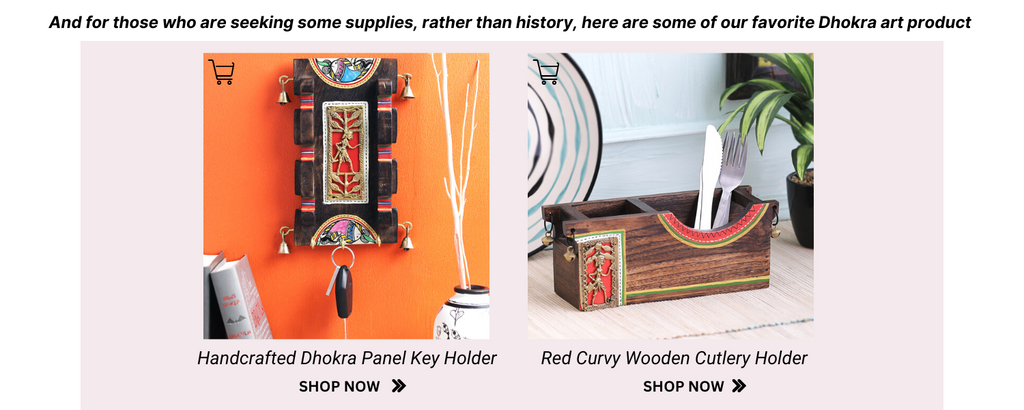History of Dhokra Art
India is famous for its rich and varied cultural heritage. The traditions are passed from generation to generation and are expressed in the form of different arts. These arts are popularly called folk art and are indigenous to every region. The famous folk arts which deserve mention is Tanjore art, Nirmal paintings, and Dhokra art. Through this article, we have shed light on the history of Dhokra art.
What is Dhokra art, and how did it originate?
Dhokra art is India’s pre-historic art form that hogged the limelight after an artifact of the dancing girl was excavated from the Mohenjodaro and Harrapan civilization. Archaeologists believe that this artifact was more than 4000 years old. The tribal art form was once done by the metal smiths of the Dhokra Damar tribe, who were nomads and moved to different places. They spread their artwork to West Bengal, Odisha, Jharkhand, Kerala, Chhattisgarh, Rajasthan, and North India. Though these tribes have a common ancestral background, the regions differ, which is reflected in the artwork.
This artwork has a strong presence in Odisha and is generally seen in Gatiguda and Jhigdi in the Rayagada district, Kankeri in the Kalahandi district, and Kuilanna and Mayurbhanj district. The artwork belongs to the Sithulia sub-caste.
How is the artwork made?
The tribal make this folk art using ancient techniques and methods that they have learned from their ancestors. The process starts with extracting metal from minerals. The technique is based on annealing, where the metal undergo high temperature that changes physical and chemical properties of a metal to increase its ductility and reduce the hardness to make it more workable. It is then pre-filled in the molds, where the cooling process of the metal begins. The mold preparation is not an easy feat as it may appear.
Though the technique has undergone several changes after the medieval era, the process remains the same. There are two ways to make the cast-hollow cast, which is traditional, and solid casting, which is a modern interpretation. While the former artwork is used in a central and eastern country, the latter is used in the southern parts like Telangana.
Steps of making this artwork
The process starts with powdering and sieving the black mud or kali mitti, which is then used to create the core clay model, it is then mixed with rice paddy or husk to create a dough. It works as a binding agent and helps to create the final cast image. Once it is done, it is exposed to the sun for drying.
In the next step, the bee wax is blended with gum and nut oil and added to the mold. When the mold is pressed on the wax, the mixture becomes long stands or spirals. These stands are used as coils and give them a distinct feature. After that, the wax is covered with red clay and rice paddy husk as an outer covering.
The brass scrap is kept inside the mold and heated at a high temperature. During this, the metal and wax melts and flows through multiple outlets. After that, it is again kept in the sun; once it is done, metal takes the form of the frame, and after that final touching is done.
Characteristics or features of Dhokra art
- It was made of low-wax casting material, and used to create figurines of animals, dancing girls, etc.
- The art is simple yet mystic.
- It is appealing.
You can add this art to your home by buying our dhokra wall hangings or handcrafted wall décor by VarEesha. We have curated these wall décor items masterfully, and it reflects Indian tradition to their best. You can visit our website or browse our collection to know more.
Here are some of our Dhokra products
Dhokra Work Wooden Towel Holder : It gives a classy look to your décor. We bring forward a collection of dining and décor accessories in wood and brass that are inspired by this ancient art form- Tales of Dhokra. You can easily maintain and clean this wooden holder.
Sheesham Wood Dhokra Work Desk Organizer / Pen Stand : We bring a range of desk organizers and holders that will not only bring the order required to your desk but also add style to your décor. It has a partition dividing the box into two different sized portions to keep your pens and small stationery items.
Upahaar Hand- Made Dhokra Wall Hanging Gift Box : Keeping festive season in mind, We have brought a range of individually curated festive gift boxes. Not only for festivals these gift boxes are ideal for housewarming too. It contains a hand painted wooden wall hanging along with two hand painted terracotta tea light holders/ diyas to bring the pious feeling of eradication of dark shadows and evil.
Hand Painted Acrylic Framed Blue Tray With Dhokra Brass Work : Ethnic decoratives in wood and metals always bring about a charm that adds a vibrancy with a rustic touch to your décor. This is a fine example of elegance and art. It has brass handles and its center gives a pretty ethnic design amidst a blue backdrop.


